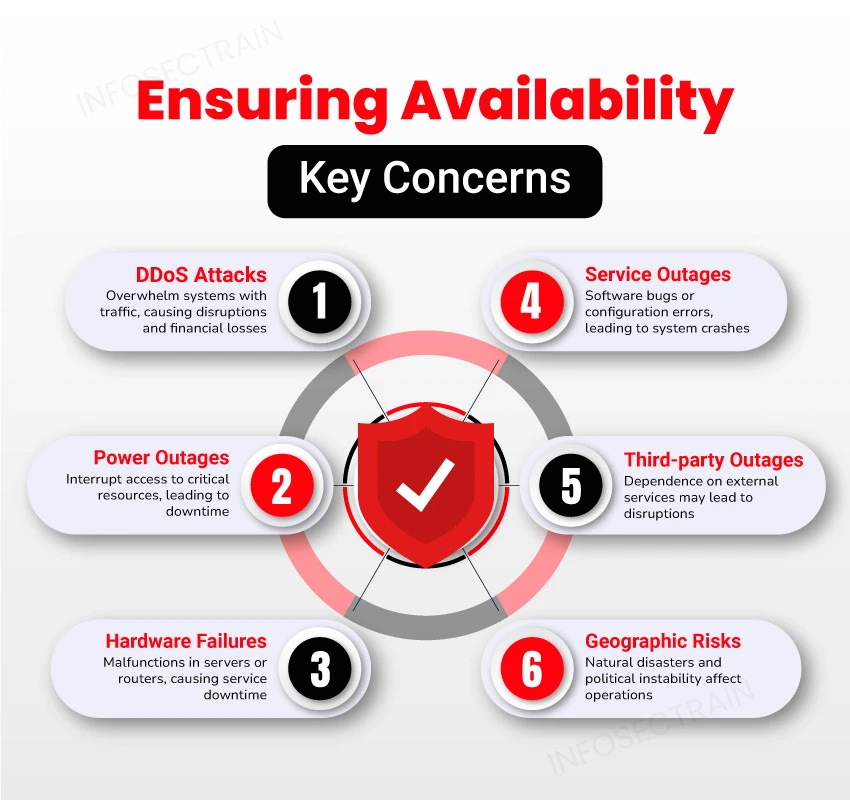Ensuring Availability: Key Concerns & Prevention
In cybersecurity, the concept of availability stands as one of the three pillars of the CIA triad, alongside confidentiality and integrity. While confidentiality and integrity primarily focus on protecting data from unauthorized access and maintaining its accuracy and reliability, availability emphasizes ensuring that systems and data are constantly accessible to authorized users when needed, free from disruptions or downtime.

Ensuring the availability of systems and assets is essential for maintaining operational continuity and preserving the trust of stakeholders. This crucial aspect of cybersecurity addresses threats and vulnerabilities that could undermine the reliability and performance of digital resources, potentially leading to significant financial losses, reputational damage, and compromised business operations.
Availability Concerns and Prevention Measures

1. Distributed Denial of Service (DDoS): A DDoS attack floods a system, network, or service with excessive traffic, overwhelming its capacity to handle legitimate requests and causing disruption or downtime for users. These attacks can disrupt online services, e-commerce platforms, and critical infrastructure, potentially leading to significant financial losses and damage to reputation.
Example: A website can be targeted by compromised devices (botnets) that flood it with excessive traffic, making it unavailable to legitimate users.
Prevention Measures
- Implement network firewalls to filter and block malicious traffic
- Implement Access Control Lists (ACLs) to restrict traffic
- Implement IDPS to identify and mitigate DoS attacks in real-time
- Utilize Content Delivery Networks (CDNs) to distribute traffic and absorb DDoS attacks
- Configure routers and switches to detect and drop packets associated with DoS attacks
2. Power Outages: Power outages pose a significant risk to the availability of critical systems and services, as they can interrupt access to vital resources and data stored in data centers and cloud environments. This could lead to data loss, downtime, and financial losses caused by natural disasters, infrastructure failures, or deliberate sabotage.
Example: A severe storm knocks out power lines or infrastructure failure results in the shutdown of data center operations, affecting hosted services and customer access.
Prevention Measures
- Install Uninterruptible Power Supply (UPS) to provide temporary power during outages
- Implementing power management and monitoring solutions helps optimize power usage and identify potential issues
- Deploy Disaster Recovery Plan (DRP)
- Implement redundant power sources and backup generators
- Empower employees with knowledge of power-saving practices
3. Hardware Failures: Hardware failures present a significant threat to availability, such as malfunctions in servers, storage devices, hardware redundancy, fault tolerance, or networking equipment like routers can lead to service downtime and data loss.
Example: A server’s hard drive fails, causing it to crash and rendering the hosted applications unavailable.
Prevention Measures
- Implement redundant systems to minimize the impact of hardware failures
- Implement server clustering and load balancing to distribute workloads across multiple servers
- Utilize proper ventilation and cooling systems
- Regularly monitor hardware health and performance to identify and replace failing components proactively
- Conduct regular backups of critical data
4. Service Outages: Service outages occur due to various factors, including software bugs, configuration errors, and human mistakes, leading to downtime and service unavailability.
Example: A software update introduces a critical bug that causes an application to crash repeatedly, resulting in service downtime.
Prevention Measures
- Implement resilient system architectures with built-in redundancy, failover mechanisms, and automated recovery processes
- Implement continuous monitoring and alerting systems
- Adopt incident response plans to ensure rapid response and recovery
- Regularly conduct stress tests and performance evaluations
5. Third-party Service Provider Outages: Third-party service provider outages occur when external services or dependencies experience downtime or disruptions. These services can include cloud computing platforms, payment gateways, Content Delivery Networks (CDNs), and other essential services.
Example: An e-commerce website experiences downtime because its payment processing service provider is facing technical issues, preventing customers from completing purchases.
Prevention Measures
- Use multiple service providers for critical functions
- Monitor service performance and reliability
- Establish contingency plans for swift provider switching
- Negotiate Service Level Agreements (SLAs) for uptime guarantees and compensation
- Maintain communication for maintenance updates and issues
6. Geographic Location Risks: Geographic location risks are the threats that come from where an organization’s infrastructure, operations, or data centers are physically located. These risks can include natural disasters, political instability, terrorism, and other regional factors that may impact availability.
Example: When a big earthquake happens in an area where there’s a data center, it can cause a lot of damage. This can lead to long-lasting downtime for the services it hosts.
Prevention Measures
- Conduct geographic risk assessments
- Establish infrastructure redundancy across regions
- Choose data center sites wisely
- Prioritize disaster recovery and continuity planning
- Monitor geopolitical developments
- Regularly update contingency plans for changing risks
How Can InfosecTrain Help?
At InfosecTrain, we provide various certification and training courses like CompTIA Security+ and Certified Ethical Hacker (CEH). These courses provide valuable insights into cybersecurity’s CIA triads. CompTIA Security+ offers a comprehensive foundation by covering common threats like DDoS attacks and mitigation strategies such as redundancy and backup systems. CEH focuses on ethical hacking techniques, equipping learners to identify vulnerabilities that could compromise availability during penetration testing. By completing these courses, individuals gain essential knowledge and skills to ensure the continuous operation of critical systems and data, contributing to the resilience of organizations against cyber threats.
TRAINING CALENDAR of Upcoming Batches For Security+ SY0-701
| Start Date | End Date | Start - End Time | Batch Type | Training Mode | Batch Status | |
|---|---|---|---|---|---|---|
| 03-May-2025 | 08-Jun-2025 | 19:00 - 23:00 IST | Weekend | Online | [ Open ] | |
| 25-May-2025 | 05-Jul-2025 | 19:00 - 23:00 IST | Weekend | Online | [ Open ] | |
| 28-Jun-2025 | 03-Aug-2025 | 19:00 - 23:00 IST | Weekend | Online | [ Open ] | |
| 26-Jul-2025 | 31-Aug-2025 | 19:00 - 23:00 IST | Weekend | Online | [ Open ] |







 1800-843-7890 (India)
1800-843-7890 (India)